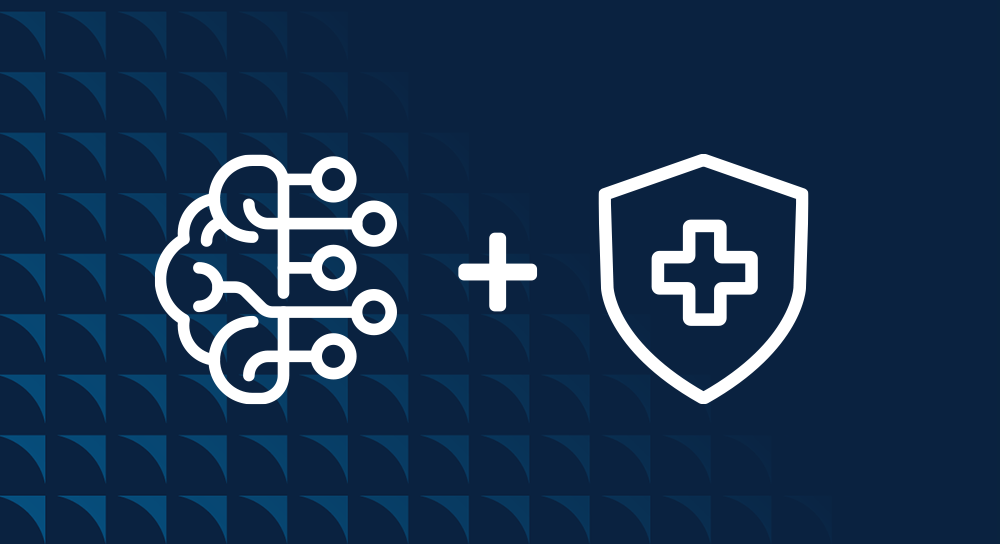With a surge in innovation around artificial intelligence (AI), health plan leaders, industry solution providers, and researchers are focused on the potential impact of AI in healthcare. In particular, emerging generative AI capabilities have captured the attention of the broad market and healthcare leaders searching for next-generation efficiencies and differentiating features.
The healthcare industry lags well behind other industries in adoption, which means there is tremendous upside if health plans can get this right. However, given the regulatory, privacy, compliance, and member service expectations, a measured approach is needed to ensure accuracy, ethical use, and privacy.
This blog explores the intersection of artificial intelligence (AI) and healthcare and then delves into how HealthEdge® helps health plans tackle the various opportunities and challenges that emerge in this domain.
The Promise of AI in Healthcare
Recent research from Harvard and McKinsey healthcare experts published in the National Bureau of Economic Research predicts wider adoption of AI could lead to a 5 to 10 percent decrease in healthcare spending in the US—about $200 billion to $360 billion every year. Researchers point out that the areas of greatest impact for administrative costs that are central to healthcare payers and providers are:
- Claims Management
- Member Services
- Corporate Functions
One of the more mature and impactful use cases is in claims management. Payers use AI-enabled core administration processing systems (CAPS) to improve auto adjudication rates, prior authorization outcomes, and fraud, waste, and abuse prevention.
Behind the frontline of provider-patient interaction, core processing and claims adjudication are inherently complex, forcing many health plans to rely on manual processes. As AI technology enters the health insurance space, payers can harness AI’s power to automate processes, improve accuracy, and enable data-driven decisions.
Examples of AI Applications in HealthRules® Payer
Today, AI offers significant gains in efficiency, given it is effectively and responsibly leveraged within the healthcare technology stack. Within HealthRules Payer, HealthEdge’s CAPS, AI-driven claims automation, analytics, and reporting efficiencies are already available. Not surprisingly, Harvard/McKinsey research predicts there is the most opportunity for AI to do more work than humans in these areas.
Let’s look at some use cases, both benefiting health plans today and others on the horizon.
AI-Powered Analytics in Claims Automation
Within claims automation, AI algorithms within HealthRules Payer review and synthesize structured and unstructured data, including encounter details, medical records, and reimbursement policies. AI identifies patterns and anomalies, helping detect fraud or unusual claim behavior and surfacing opportunities to streamline the entire claims processing workflow. By supporting human reviewers and making auto-adjudication more intelligent, AI improves the accuracy and efficiency of complex claims reviews.
HealthRules Payer processes millions of claims. Health plans are under tremendous pressure to automate as much as possible to pay claims within 30 days or face steep penalties. Within HealthRules Payer, AI looks at all the claims requiring human intervention and understands the decisions being made. For example, the health plan can learn which combination of doctor, service, and dollar amount needs to be reviewed by a person. The AI models ensure maximum intelligent automation so that health plan staff can focus on the exceptions.
Therefore, auto-adjudication rates are optimized. Many health plans historically have averaged about 75+% auto-adjudication rates, but improving that by 5% would be optimal as they implement new technologies. HealthEdge found that a 1% increase in auto-adjudication is close to $400K in savings for health plans using HealthRules Payer. Traditional AI, or machine learning, in HealthRules Payer helps these organizations raise their auto-adjudication rates by identifying patterns and focusing on which to automate.
HealthEdge’s Payment Integrity platform Source is also implementing traditional AI algorithms to ensure that claims are paid accurately. According to estimates by the Centers for Medicare and Medicaid Services (CMS) approximately 9.5% of claims are paid inaccurately, which contributes to nearly $36 billion in overpayments. Reprocessing such claims and recovering payments increase the administrative burden on plans and also lead to abrasion in plan-provider relationships. AI algorithms are employed to find inaccuracies before a payment is made in order to improve accuracy.
Natural Language Reporting Queries
HealthRules Payer complements core reporting and analytics capabilities by allowing users to ask natural language questions about specific aspects. Each day, users have questions about vital operational metrics and want to dig deeper into these metrics better to understand information not readily available in existing reports. They may have specific inquiries that lead to curiosity to look deeper into things like daily claim volume, claims assigned to humans, auto adjudication rates, instances of overpayment, etc.
HealthEdge has put a spin on traditional reporting, which does a good job of answering the questions most health plan leaders want, but it doesn’t necessarily support human curiosity. If a report triggers a question such as “Why is that hospital billing the highest?” HealthRules Payer with AI allows the user to ask that question and instantly receive an answer. Similarly, if a user wants to know “Which services are the most expensive for this hospital in this time frame?” the application generates the answers.
Before AI, a business analyst or even a data scientist would get a long list of questions to explore, and those questions pile up, leading to delays in decision-making and insightful action. Now, HealthRules Payer eliminates those delays and instantly provides more insightful action. How many questions about data does a user have in a single day? Now, multiply that by all the leaders and users in a health plan. You start to see how powerful AI can be, making everyone more informed and streamlining decision-making.
Human-Friendly User Support and Training
Another powerful use case is for HealthEdge users who need to query our extensive product documentation, which spans approximately 8,000 pages. Traditionally, users would search through this documentation to understand product details. Getting to the answer can be cumbersome, involving trial and error to find what information is needed. Health plans often contact customer support or product managers to seek guidance on specific tasks, adding more time to solving the problem.
To address this challenge, HealthEdge developed an application in HealthRules Payer that leverages generative AI. This technology allows users to ask questions about the product using natural language, and the system provides accurate answers. Unlike manual searches, this approach is like interacting with a chatbot, streamlining the process and eliminating the need for time-consuming and exhaustive searches.
What is generative AI?
Generative artificial intelligence (generative AI) is a type of AI that can create new content and ideas, including conversations, stories, images, videos, and music. AI technologies attempt to mimic human intelligence in nontraditional computing tasks like image recognition, natural language processing (NLP), and translation. Generative AI is the next step in artificial intelligence.
Work in Progress: Generative AI for Member Services
A future application currently being explored demonstrates the potential efficiencies generative AI can deliver when it comes to care management with the HealthEdge GuidingCare® member engagement solution.
When members contact a service representative, they often inquire about their health insurance benefits. For instance:
- The member asks how many physical therapy sessions they can be reimbursed for in a year or the cost of visiting a chiropractor.
- The service representative manually navigates through the system to retrieve this information, which takes time for both parties on the call and depends on a person to interpret.
- The member may be frustrated and feel that insurance coverage is a “black box” and a time-consuming burden to decipher.
Leveraging natural language processing in a chat-based interface will allow representatives to quickly access and provide accurate benefit details to members during live calls. Ensuring 100% accuracy is crucial, which HealthEdge is working toward now. Although the project is still in progress, HealthEdge believes this will streamline benefit inquiries, improve service, and enhance customer satisfaction.
A Bright Future: Streamlining Staff Workflowswith Summarization
Finally, there are future use cases that illustrate how generative AI can be used in healthcare. For example, when a patient requires a knee replacement, the health plan must approve the procedure through prior authorization. GuidingCare handles the case review during this, which involves a physician thoroughly examining a patient’s documentation. Often, these documents are hundreds of pages.
AI could be used to summarize the critical aspects of the documentation. By condensing the essential information, a physician can make a quicker decision, which leads to faster approval and more timely care. This efficiency is crucial because physician reviews are resource-intensive and critically important. Optimizing this process helps all stakeholders and can significantly impact the operational bottom line.
Similarly, the Wellframe team is planning to embed Generative AI summarizers into staff workflows such that case managers can rapidly and quickly catch up on the latest member activity across the Wellframe platform, including recent chats/inquiries, app activity, care program / assessment results without disrupting existing workflows.
However, much work remains to ensure accuracy and address ethical considerations associated with summarization. Balancing efficiency with accuracy and ensuring transparency is a priority for HealthEdge.
The Challenges of AI in Healthcare
Despite AI’s current benefits and promise for health plans, HealthEdge is deeply mindful that a cautious approach, ethical considerations, and continuous monitoring are vital to reap AI’s benefits while minimizing risks. It’s imperative to:
- Mitigate ethical and legal risks with privacy
- Establish best practices in data and systems governance, and
- Monitor the potential for “bias” in AI algorithms
These practices are critical for reliable AI applications. Above all, patient safety and cybersecurity must be prioritized, and risks must be mitigated. Within HealthEdge, all AI/ML use cases are vetted from ideation to deployment by an AI Governance Panel, which has legal, information security, compliance, business, and engineering leaders within the organization.
Relative to the use cases above, there are key considerations for the use of AI:
Probability and margins for error
With the incorporation of AI into intelligence that drives auto-adjudication systems, for example, probability and margins for error must be considered. Of course, even human reviews have inherent inaccuracies, but health plans want to improve that performance baseline while maximizing efficiency.
With HealthRules Payer, health plans can select their desired accuracy level, such as 95% or 100%. For instance, if a customer is comfortable with a 95% confidence level for a certain process, there is a 5% chance of misclassification. This aligns with the reality that human reviews are also subject to errors due to imperfect data. HealthEdge communicates this to health plans, allowing them to adjust the risk-reward ratio according to their needs. Relative to emerging generative AI, this process is relatively straightforward with machine learning.
Mitigating generative AI risks
The situation changes when it comes to generative AI, which relies on large language models. These models can generate content beyond the input data (often referred to as “hallucinations”) because they are designed to create new material. While this is advantageous for tasks like video generation or fun consumer applications, it becomes problematic when dealing with critical healthcare information.
Consider member benefits. Here, there is no room for error. If a member is told they have six visits for physical therapy, but the actual data indicates only four visits, the consequences could be significant. Generative AI excels at recommendations and answering questions. Yet, accuracy becomes paramount when dealing with essential details like insurance benefits or product documentation, so HealthEdge has implemented extensive pre- and post-deployment validation procedures. While health plans are excited about the potential benefits sooner rather than later, they can have confidence that HealthEdge’s oversight of these innovative possibilities will ensure the application is ready to go when brought to market.
Conclusion
AI holds immense promise for health plans. As HealthEdge invests in innovating with AI, it prioritizes a close partnership with health plans to maximize the benefits and mitigate the risks. The bottom line is that AI is adding powerful capabilities today in HealthRules Payer, and HealthEdge is focused on diligence when adding generative AI into solutions. The result will be that healthcare works better for everyone.
To learn more about how HealthEdge’s solution can help your organization leverage AI to improve efficiencies, reduce costs, and stay on the leading edge of healthcare innovation, visit www.healthedge.com.





